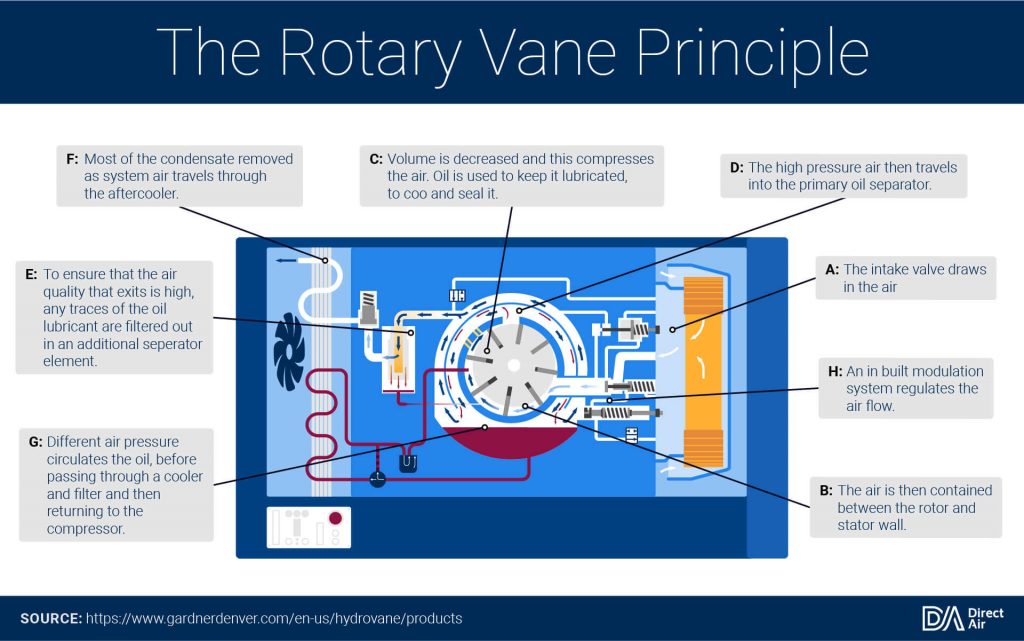
Air Compressors: How Do They Work?
An incredibly valuable tool, air compressors are essential to many industries and tasks. With a number of uses from pneumatic tools to air conditioners, Direct Air has created a graphic to give a true understanding of how they work.
There are many varieties of these machines, below is a brief overview to help you choose the right air compressor for the job at hand.

Single and Dual Phase
These models follow a similar method to each other, dual compressors simply have one extra step in their process. Air is drawn into a cylinder and compressed with a single piston movement.
Dual phase follows this but will send the air into a second cylinder to be compressed again. Both then send the air to a storage tank until required.
Dual phase compressors are typically suited to an industrial environment while single phase are more commonly used within DIY.
Oil-Free and Oil-based
All air compressors must be lubricated in order to draw air in efficiently and safely.
Oil-free have a non-stick coating, such as Teflon within the cylinder and oil-based require oil to be applied to the piston area.
Oil-free are typically cheaper to purchase and maintain but will often have a shorter lifespan as this coating will eventually wear down.
Oil-based are more costly to purchase and require more maintenance and regular oil checks. They also have more elements to the machine so are heavier.
However, they are more robust and suited to heavy-duty tasks, on average will last longer than their counterparts.
Fixed and Variable
A fixed speed air compressor will send a continuous and consistent power stream to the motor. This in turn gives reliable frequency. They are cheaper to buy and maintain.
A variable speed compressor automatically adjusts the speed of the motor in accordance with the demand for air. This means they are far more energy efficient than a fixed speed and therefore more affordable to run.
Scroll Compressors
The most common form of air compressor, a piston travels downwards to decrease pressure and forces the cylinder open. Air is drawn in and then forced out at a higher pressure point when the piston travels up again.
Scroll compressors are more energy efficient and can cool down quickly, they are however harden to maintain.
Rotary Screw Compressors
Instead of pistons, these compressors use rollers. These are positioned in the middle of the shaft with the side of the roller always in contact with the wall. These then rotate at an extreme speed, mimicking that of a piston.
Rotary screw compressors have a great power capacity and are easy to maintain. They do require regular maintenance checks and have limited cooling abilities.
Low Noise Air Compressors
A typical complaint of air compressors is the loud noise levels. Low noise air compressors are available. These work by having an acoustic chamber built in that contains the noise and reduces the decibel level to around 40dB.
Latest news

18th April 2024
Abloy UK showcases new digital portfolio at The Security Event 2024
Abloy UK is set to unveil its latest line-up of access control systems at The Security Event 2024, welcoming guests to explore its cutting-edge electromechanical and digital solutions on stand 5/F50.
Posted in Access Control & Door Entry Systems, Architectural Ironmongery, Articles, Building Industry Events, Building Industry News, Building Products & Structures, Building Services, Doors, Exhibitions and Conferences, Facility Management & Building Services, Health & Safety, Information Technology, Retrofit & Renovation, Security and Fire Protection
18th April 2024
Strand is a Failsafe Choice for Emergency Exit and Panic Hardware
In times of emergency, you’re in safe hands with Strand Hardware. Although there are many considerations for building specification, few decisions can be as critical as selecting the right emergency exit/panic hardware.
Posted in Access Control & Door Entry Systems, Architectural Ironmongery, Articles, Building Industry News, Building Products & Structures, Building Services, Doors, Facility Management & Building Services, Health & Safety, Restoration & Refurbishment, Retrofit & Renovation, Security and Fire Protection
18th April 2024
MRA appoints Callum Budd as Research Projects Director
MRA Research, the research agency focused solely on the construction sector, welcomes Callum Budd as its new Research Projects Director.
Posted in Articles, Building Industry News, Information Technology, news, Recruitment, Research & Materials Testing
16th April 2024
Mitsubishi Electric set to host CIBSE Journal webinar
Mitsubishi Electric will host a CIBSE Journal webinar on Wednesday 24th April 2024 at 1pm to discuss the legislation and initiatives driving changes in the way we will need to heat, cool and ventilate large commercial buildings to reach net zero emissions in the UK.
Posted in Air Conditioning, Articles, Building Industry Events, Building Industry News, Building Products & Structures, Building Regulations & Accreditations, Building Services, Facility Management & Building Services, Heating Systems, Controls and Management, Heating, Ventilation and Air Conditioning - HVAC, Information Technology, Pipes & Fittings, Plumbing, Seminars, Sustainability & Energy Efficiency, Training
 Sign up:
Sign up: